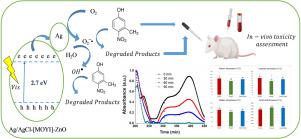Environmental Technology & Innovation ( IF 6.7 ) Pub Date : 2020-10-20 , DOI: 10.1016/j.eti.2020.101212 Mohsen Padervand , Hamed Heidarpour , Mahsa Goshadehzehn , Sima Hajiahmadi

|
In this work, a facile ionic liquid-mediated method was utilized to fabricate an efficient photocatalyst for the environmental remediation. The eco-friendly aspect of the treatment was explored through an in-vivo toxicity bioassay. ZnO particles, prepared by a combined solid state-pyrolysis method, were coated by 1-methyl-3-(oxiran-2ylmethyl)-1H-imidazolium-3-chloride ([MOYI]Cl) ionic liquid. Then, Ag/AgCl species were grown on the surface to make a heterojunction system leading to efficient charge separation and light absorption extension to the visible domain. The products were characterized by XRD, FTIR, SEM, EDX, DRS, BET, and PL analysis. Photocatalytic performance of the nanostructures was evaluated by the degradation of 3-methyl-4-nitrophenol (from the semivolatile organic compounds, SVOCs, family) solutions under visible light. According to the results, the photocatalyst was able to completely degrade the pollutant and decrease the amount of COD from 210 to 32 mg/L within 90 min of the photoreaction. Reusability studies revealed that the degradation efficiency slightly decreased to 92% after five repetitive experiments. In order to investigate the eco-friendly aspect of the treatment procedure, an in-vivo bioassay was conducted to evaluate the acute toxicity of the contaminant solution, before and after the photochemical reaction, in terms of physical, biochemical and hematological markers of the laboratory rats. LC-MS analysis was applied to identify the chemical structure of the reaction products and propose the most probable reaction pathway. The results showed that the photocatalytic treatment over the prepared materials is an eco-friendly and reliable method to effectively transform of such toxic contaminants into non-toxic or less harmful compounds.
中文翻译:

Ag / AgCl修饰/ [MOYI]涂层/ ZnO纳米结构上的3-甲基-4-硝基苯酚的光催化降解:材料表征,光催化性能和光产物的体内毒性评估
在这项工作中,一种简便的离子液体介导的方法被用来制造一种有效的光催化剂来进行环境修复。通过体内试验探索了治疗的环保性毒性生物测定。通过1-甲基-3-(环氧乙烷-2-基甲基)-1H-咪唑-3-氯化物([MOYI] Cl)离子液体涂覆通过组合固态热解法制备的ZnO颗粒。然后,在表面上生长Ag / AgCl物种以形成异质结系统,从而导致有效的电荷分离和光吸收扩展到可见域。通过XRD,FTIR,SEM,EDX,DRS,BET和PL分析对产物进行表征。通过在可见光下降解3-甲基-4-硝基苯酚(来自半挥发性有机化合物,SVOC,家族)溶液来评估纳米结构的光催化性能。根据结果,光催化剂能够在光反应90分钟内完全降解污染物并将COD量从210降低至32 mg / L。可重复使用性研究表明,经过5次重复实验,降解效率略有下降,降至92%。为了研究处理程序的环保方面,进行了体内生物测定,以根据实验大鼠的物理,生化和血液学指标评估光化学反应之前和之后污染物溶液的急性毒性。LC-MS分析用于鉴定反应产物的化学结构,并提出最可能的反应途径。结果表明,对所制备的材料进行光催化处理是一种生态友好且可靠的方法,可有效地将此类有毒污染物转化为无毒或危害较小的化合物。











































 京公网安备 11010802027423号
京公网安备 11010802027423号